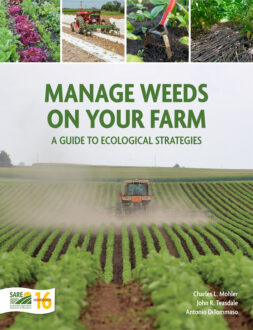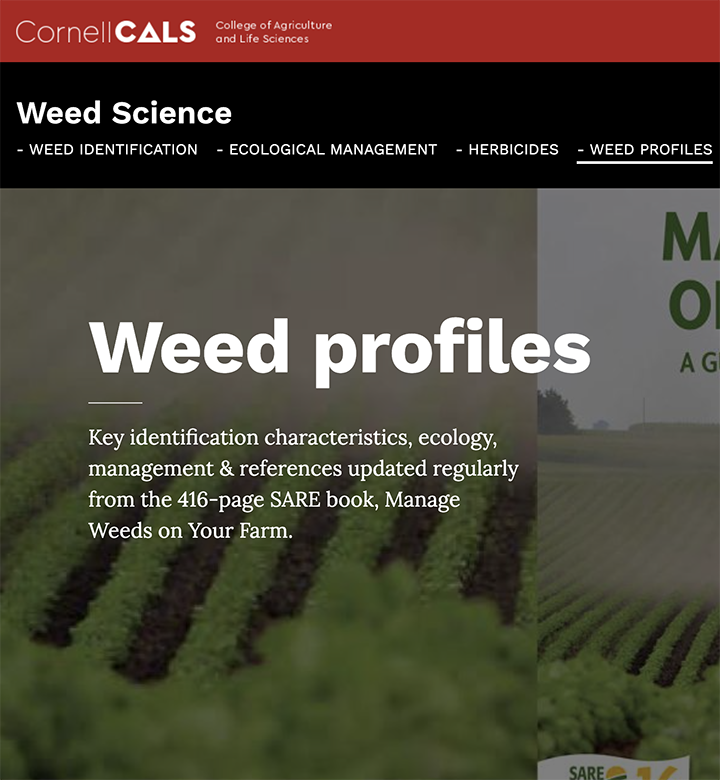Other common names: corn sow thistle, field sowthistle, creeping sow thistle, gutweed, milk thistle, field milk thistle, swine thistle, tree sow thistle, dindle, marsh sowthistle
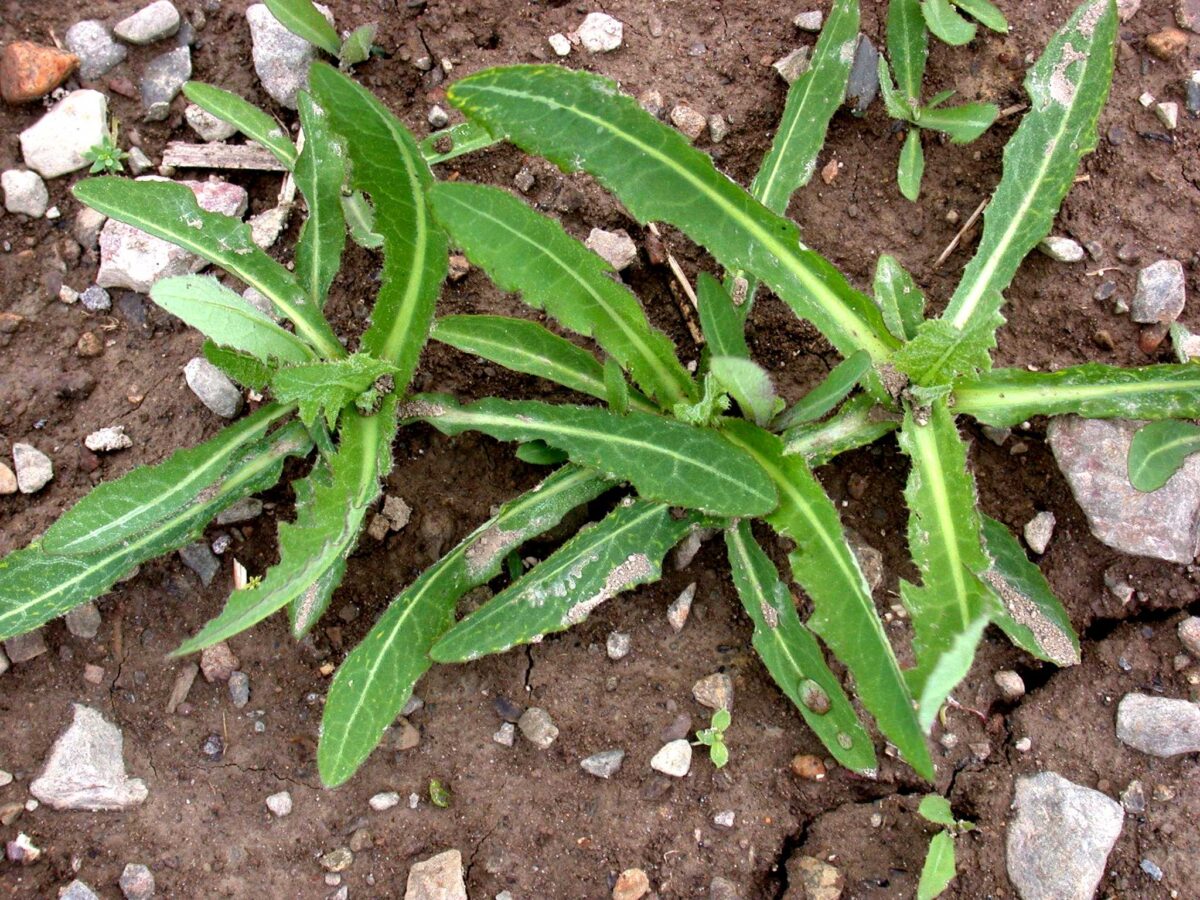
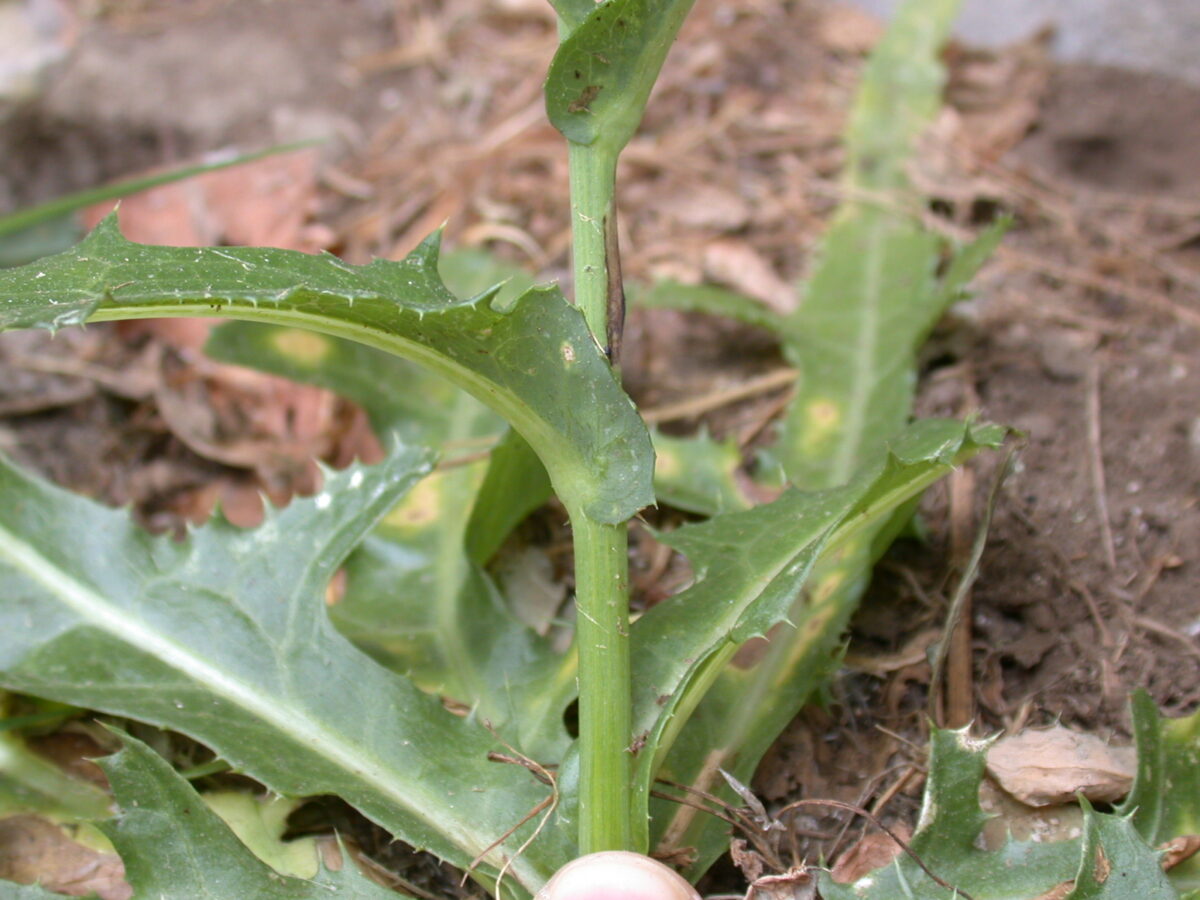
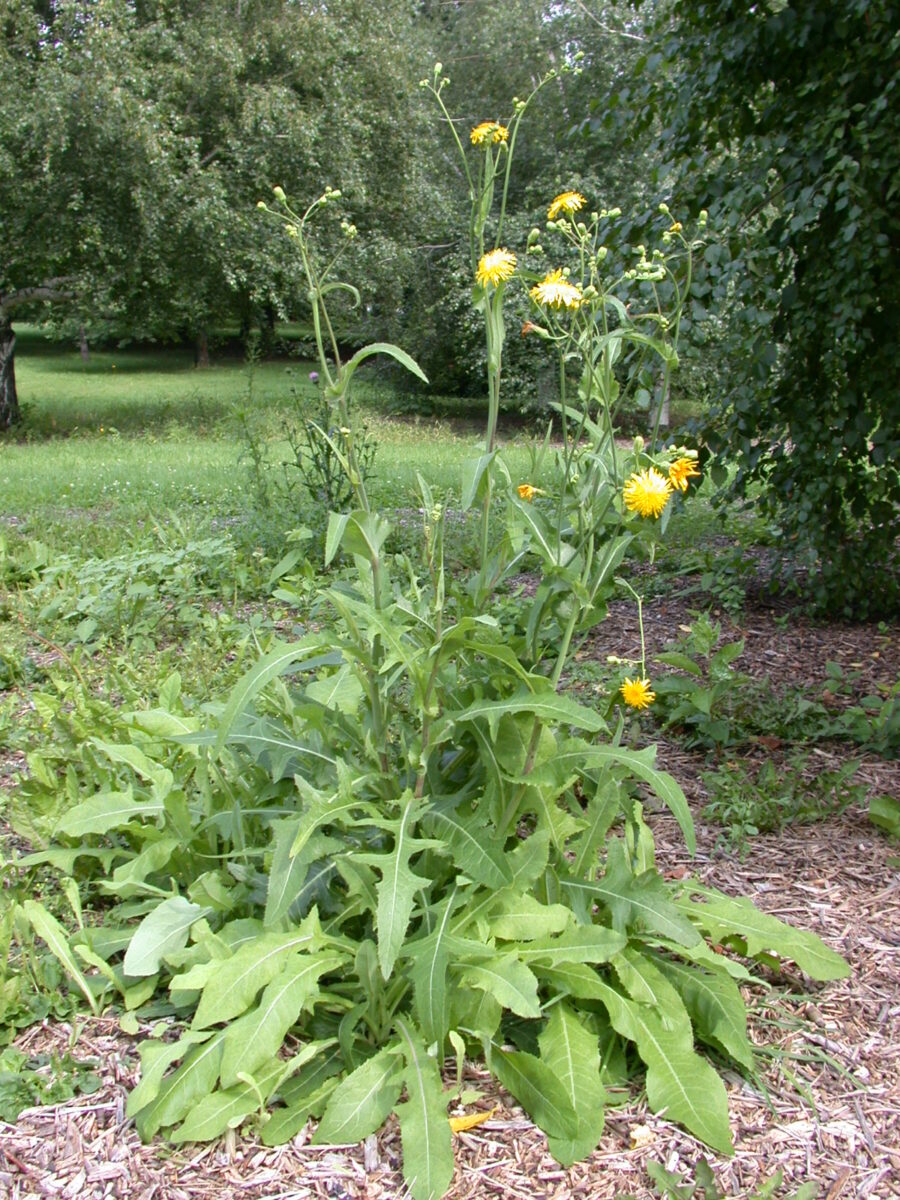
Sonchus arvensis L.
Identification of Perennial Sowthistle
Family: Aster family, Asteraceae
Habit: Erect, mostly unbranched, perennial herb arising from a basal rosette and spreading by shallow, thickened storage roots
Description: Seedlings have short-lived, slightly fleshy, 0.2–0.3 inch-long by 0.05–0.2 inch-wide, round or oval cotyledons with a small notch at the tip. The first true leaves are paddle shaped, irregularly toothed along the margins and dull blue-green. Young leaves form a rosette and are lanceolate, alternate and hairless, with prickly teeth along the margins and leaf stalks. Teeth point towards the base of the leaf. All parts exude a white sap when injured. Mature plants are 2–5 feet tall, with hollow stems that may branch at the top. Stems are hairless towards the base, with sparse to dense gland-tipped hairs towards the top, or occasionally the top is hairless. Leaves are lanceolate, 2–16 inches long by 1–4 inches wide, alternate, hairless and irregularly lobed. Leaf margins are toothed and prickly. Leaves are larger and more densely arranged on the lower stem. Lower leaves have two to six triangular to lanceolate lobes or are occasionally unlobed. Lobes on the upper leaves are reduced or absent. Leaf bases have a pair of rounded lobes that clasp the stem. The root system is extensive and can reach up to 10 feet in depth and spread over 9 feet horizontally. Roots are yellow-white, thick, brittle and fleshy, with buds that can produce vegetative shoots from up to 20 inches below ground. Small clusters of flower heads develop at the end of upper stems and branches. Each bright yellow, dandelion-like flower head is 1–2 inches wide. At the base of each flower head are overlapping, narrow bracts. Each bract is 0.5–1 inch long, with many short, yellow gland-tipped hairs (occasionally hairless). The apparent seed includes a thin, tight coat of fruit tissue. These seeds are red-brown to dark brown, rectangular, 0.1–0.14 inch long by 0.04–0.06 inch wide and have five to 12 longitudinal ridges. Each seed is attached to a feathery, white 0.4–0.6 inch-long pappus.
Similar species: Prickly lettuce (Lactuca serriola L.), annual sowthistle (Sonchus oleraceus L.) and spiny sowthistle [Sonchus asper (L.) Hill] are similar to perennial sowthistle. Prickly lettuce seedlings are hairy and leaves of mature plants have a distinctive row of sharp spines along the underside of the midvein. Annual and spiny sowthistle flower heads are only 0.75 inch or smaller, and the seeds have fewer ridges than those of perennial sowthistle. Spiny sowthistle leaves have larger, spinier teeth than perennial sowthistle leaves, while annual sowthistle leaves lack prickles. Annual sowthistle leaves usually have a large triangular terminal lobe that is not found in the other two sowthistle species. All three species are annuals and have taproots rather than the extensive root system of perennial sowthistle.
Management of Perennial Sowthistle
Because perennial sowthistle thrives best in wet soils, improving soil drainage can improve control. In particular, improving soil drainage will improve the ability of your crops to competitively suppress the weed.
As with most creeping perennial weeds, good control involves fragmenting the root system to weaken subsequent regrowth, repeatedly killing the shoots and strong competition from crops. In Scandinavian studies, weight and carbohydrate storage in the roots reached a minimum in late May, and this corresponded to the five- to seven-leaf stage of development. Burial of the plant at that stage reduced the number of shoots produced the rest of the season relative to burial earlier or later. Subsequently turning new shoots under two to three times when they reached four to six leaves killed the storage roots completely. Performing the operations at the four-leaf stage eliminated the plants in 74 days or less but required one to three additional operations, whereas waiting until the six-leaf stage required up to 84 days but only required one to two additional operations. The four- to six-leaf stage was reached by 3 inch root fragments in about two to three weeks, and this corresponded to the point at which the root fragments were most depleted. Similar to the tillage experiments, cutting the shoots off just below soil level when they reached the six-leaf stage eliminated the storage roots in three operations, whereas cutting the shoots at four leaves required four operations. Waiting until the plants had six leaves caused shrinkage of the storage roots but not complete death in one experiment but produced the most rapid elimination of the plants (42 days) in another experiment.
In general, a well-planned tillage fallow period can eliminate the weed in time to plant a winter grain or late season vegetable crop. Spring plowing is more effective than autumn plowing for control of perennial sowthistle. Fallow tillage in the fall is less effective than tillage in the spring because the buds become dormant and do not sprout readily in the fall. Nevertheless, tillage following grain harvest can be a useful control tactic because it kills top growth that is feeding the storage roots and because breaking up the storage roots makes the plants less vigorous in the spring. Two years of hay mowed three times per season also substantially reduces perennial sowthistle density.
As with most perennial weeds, cutting up the roots with tillage implements greatly decreases the vigor of the subsequent shoots. Moreover, burying the small fragments 8–12 inches deep also reduces the number and subsequent vigor of the shoots. Thus, some European organic growers control the weed by chopping the storage roots into small pieces with a disk or field cultivator and then moldboard plowing to bury the fragments. When the shoots from deeply buried small fragments were allowed to grow unchecked, they produced large storage roots by the end of the season so that chopping up and burying the roots was essentially futile if no further actions were taken. When fields were planted with barley, however, the combination of fragmentation, deep burial and crop competition resulted in a substantial decrease in weight of storage roots. A short tilled fallow period could probably be substituted for the deep tillage in this control strategy.
Ecology of Perennial Sowthistle
Origin and distribution: Perennial sowthistle is native to Europe and western Asia and is most common in northwestern Europe. It has been introduced into North and South America, Australia and New Zealand. It is distributed throughout the northern United States and southern Canada but only occurs sporadically in the southern and southwestern states.
Seed weight: Mean population seed weights range from 0.38–0.69 mg.
Dormancy and germination: Seeds have little or no innate dormancy and will readily germinate immediately after dispersal. Seeds germinate best at 77–86°F. Few seeds will germinate at constant temperature outside this range, but fluctuating temperatures with the high above 86°F increase germination. Many perennial sowthistle seeds will germinate in the dark, but exposure to light increases the germination. Seeds can tolerate wetting for five days and subsequent drying without losing viability.
Seed longevity: Few seeds last in the soil longer than five years. Most seeds (80%) germinate within the first year. Seeds apparently survive better in clay soils than in sandy loam. In soil worked three times a year, mortality of seeds was 48–65% per year.
Season of emergence: Seedlings emerge primarily in late spring through mid-summer. Shoots begin emerging from rootstocks as soon as the soil warms, which is late April in many of the areas where the weed is a major pest.
Emergence depth: Seedlings emerge best from the top 0.2 inch of soil, though a very few can emerge from as deep as 1.2 inch. Root fragments can produce shoots from anywhere in the plowed horizon, but emergence from fragments at the soil surface or deeper than 8 inches is reduced. Shoots from small, deeply buried fragments are weaker and may not emerge at all.
Photosynthetic pathway: C3
Sensitivity to frost: Shoots die back after frost. Overwintering roots survive soil temperatures as low as 3°F without damage but cannot survive -4°F.
Drought tolerance: Perennial sowthistle seedlings are highly sensitive to drying and generally only establish in wet spots or in areas where crop residues or cover of other plants keep the soil moist. Plant growth is best in saturated soil and is progressively reduced at field capacity and lower soil moisture levels. Well established plants, however, often have some deep roots that help the plant survive dry periods.
Mycorrhiza: There have been two reports of the presence of mycorrhiza on this species and one report of their absence.
Response to fertility: Perennial sowthistle does best on neutral to slightly alkaline soils. Plant growth was optimum at pH 6.2 and 7.2 but 30% lower at pH 5.2. Nitrogen had little influence on shoot emergence but increased the mass of thickened roots by fall. The species accumulates higher N, P, K and Mg concentrations than winter wheat and higher K and Ca concentrations than spring barley. It can achieve K tissue concentrations of 5%.
Soil physical requirements: Perennial sowthistle is most common on loam or clay soils, particularly in areas with high precipitation, and it is relatively rare on dry, sandy and gravelly soils. Compaction reduces its growth and ability to produce new shoots. The species tolerates moderate salinity, but only in wet soils.
Response to shade: Perennial sowthistle is sensitive to shade. Plant weight and reproduction are reduced in shade, and leaf growth increases at the expense of stems and roots as shade increases.
Sensitivity to disturbance: Ability of young plants to re-establish if the root is fragmented develops within a few weeks of seedling emergence. Basal stems and new roots growing from established plants have the same capacity for vegetative reproduction. Most of the thickened roots from which new plants arise lie within the top 8 inch plow layer where they can be broken up by tillage implements. This creates more, but weaker, sprouts. Deep burial of root fragments by inversion tillage reduces the number and vigor of subsequent sprouts. Thickening of new roots into overwintering storage roots begins when the shoot has five to seven leaves. Buds on storage roots become dormant in late summer and fall, so tillage late in the season does not induce a flush of new shoots. Bud dormancy is enhanced primarily by shortening day length but maximally in combination with temperatures below 62°F. Bud dormancy is overcome by exposure to 36–40°F for a month or more.
Time from emergence to reproduction: Most plants do not flower during their first year unless conditions are highly favorable. Flowering begins when the shoot has 12–15 leaves, which is in early July in the northern United States. Flowering continues until late summer. Initiation of flowering is delayed several weeks by soil moisture below field capacity and by shading. Seeds develop about 10 days after the flowers open.
Pollination: Perennial sowthistle is pollinated by bees, flies and blister beetles. The species does not self-pollinate, and thus populations consisting of a single clone do not produce seeds.
Reproduction: Perennial sowthistles produce an average of about 30 seeds per head. A particularly large, isolated shoot reportedly produced 62 seed heads and nearly 10,000 seeds, but in our experience, five to 20 seed heads is more typical of plants growing in agricultural fields. Seeds can mature on cut stems once the flowers are pollinated. Spreading roots are the primary means of vegetative reproduction, and they enable plants to spread rapidly. The edges of clones of perennial sowthistle in North Dakota spread outward at a rate of 1.6–9.2 feet per year.
Dispersal: Tufts of hairs help wind disperse seeds moderate distances, but seeds probably rarely disperse farther than the adjacent field by wind. Hooked cells on the hairs cause the seeds to cling to fur and clothing. The species also spreads in contaminated seed and hay, and in combines. Since storage roots are mostly in the plow layer, root fragments probably disperse in soil clinging to tillage machinery.
Common natural enemies: Perennial sowthistle is susceptible to several nematodes, including root-knot nematodes (Meloidogyne incognita) and cyst nematodes (Heterodera sonchophila). It is also susceptible to Pseudomonas solanacearum wilt, but plants typically recover from wilting symptoms in the evening. Although several insect species have been explored for biological control of perennial sowthistle, none have demonstrated significant impact on populations of this species.
Palatability: The leaves have sometimes been eaten as a salad or pot herb. Perennial sowthistle is acceptable quality forage for most livestock but not lambs.
Summary Table of Perennial Sowthistle Characteristics
| Perennial Sowthistle | ||||||||
|---|---|---|---|---|---|---|---|---|
| Growth habit | Perennial overwinter organ | Emergence period from perennial organs | Optimum emergence depth (inches) from perennial organs | Time/stage of lowest reserves | Photosynthesis Type | Frost Tolerance | Drought Tolerance | Mycorrhiza |
| medium, erect | thickened roots | mid-spring | 1–8 | 5–7 leaves | C3 | low | low | unclear |
| Fertility Response | Importance of seeds to weediness | Seed weight (mg) | Dormancy of shed seeds | Factors breaking dormancy | Optimum temperarature range (F) for seed germination | Seedling emergence period | Emergence to flowering (weeks) | |
| low | moderate | 0.38–0.69 | no | li, at | 77–86 | late spring to mid-summer | 10–14 | |
Table Key
Drought tolerance: Relative tolerance of aboveground plants to drought (high, moderate, low).
Emergence period from perennial organs: Time of year when most emergence occurs from perennial overwintering organs in the typical regions of occurrence for each weed. Some emergence may occur outside of this range.
Emergence to flowering: Length of time (weeks) after emergence from perennial organs to the beginning of flowering in the typical regions of occurrence. Note that this refers to established perennial plants, recognizing that some species may not flower in their initial year of establishment.
Factors breaking dormancy: The principle factors that are reported to break dormancy and facilitate germination. The order of listing does not imply order of importance. Abbreviations are:
- scd = seed coat deterioration
- cms = a period subjected to cold, moist conditions
- wst = warm soil temperature
- li = light
- at = alternating day-night temperatures
- ni = nitrates
Flowering to viable seed: Length of time (weeks) after flowering for seeds to become viable.
Frost tolerance: Relative tolerance of aboveground shoots to freezing temperatures (high, moderate, low).
General: The designation "-" signifies that data is not available or the category is not applicable.
Growth habit: A two-word description. The first word indicates relative height (tall, medium, short, prostrate) and the second word indicates degree of branching (erect, branching, vining).
Importance of seeds to weediness: The relative importance of seeds to dispersal, genetic diversity and survival of the species as a weed in agricultural environments (high, moderate, low).
Mycorrhiza: Presence of mycorrhizal fungi. “Yes” if present; “no” if documented not to be present, “unclear” if there are reports of both presence and absence; “variable” if the weed can function either with or without, depending on the soil environment.
Optimum emergence depth from perennial organs: Soil depths (in inches below the soil surface) from which most shoots emerge from perennial organs. Lower rates of emergence usually will occur at depths above or below this range.
Optimum temperature range for germination: Temperature (Fahrenheit) range that provides for optimum germination of non-dormant seeds. Germination at lower percentages can occur outside of this range. The dash refers to temperature range, and the slash refers to alternating day/night temperature amplitudes.
Perennial overwinter organ: Principal plant organ that survives winter and from which growth resumes in subsequent years.
Photosynthesis type: Codes “C3” or “C4” refer to the metabolic pathway for fixing carbon dioxide during photosynthesis. Generally, C3 plants function better in cooler seasons or environments and C4 plants function better in warmer seasons or environments.
Pollination: “Self” refers to species that exclusively self-pollinate; “cross” refers to species that exclusively cross-pollinate; “self, can cross” refer to species that primarily self-pollinate, but also cross-pollinate at a low rate; and “both” refers to species that both self-pollinate and cross pollinate at relatively similar rates.
Response to nutrients: Relative plant growth response to the nutrient content of soil, primarily N, P, K (high, moderate, low).
Seed dormancy at shedding: “Yes” if most seeds are dormant when shed; “Variable” if dormancy is highly variable; “No” if most seeds are not dormant.
Seed mortality in tilled soil: Range of mortality estimates (percentage of seed mortality in one year) for seeds in tilled soil. Values were chosen for seeds placed within the tillage depth and subjected to at least annual tillage events. Seed losses are the result of dormancy-breaking cues induced by tillage, germination and deterioration of un-germinated seeds.
Seed mortality in untilled soil: Range of mortality estimates (percentage of seed mortality in one year) for buried seeds in untilled soil. Values were chosen where possible for seeds placed at depths below the emergence depth for the species and left undisturbed until assessment. Mortality primarily represents seed deterioration in soil.
Seed weight: Range of reported values in units of “mg per seed."
Time/stage of lowest reserves: Time of year and/or weed growth stage at which carbohydrate reserves are lowest. This usually corresponds to the time when the weed is most susceptible to weed management operations.
Typical and high seed production potential: The first value is seed production (seeds per plant) under typical conditions with crop and weed competition. The second value, high seed production, refers to conditions of low density without crop competition. Numbers are rounded off to a magnitude that is representative of often highly variable reported values.
Typical emergence season: Time of year when most emergence occurs in the typical regions of occurrence for each weed. Some emergence may occur outside of this range.
Weed: Weed common name as listed in the Weed Science Society of America Composite List of Weeds, presented in alphabetical order.
Further Reading
Brandsæter, L.O., K. Mangerud, M. Helgheim and T.W. Berge. 2017. Control of perennial weeds in spring cereals through stubble cultivation and moldboard ploughing during autumn or spring. Crop Protection 98: 16–23.
Lemna, W.K. and C.G. Messersmith. 1990. The biology of Canadian weeds. 94. Sonchus arvensis L. Canadian Journal of Plant Science 70: 509–532.
Håkansson, S. and B. Wallgren. 1972b. Experiments with Sonchus arvensis L. III. The development from reproductive roots cut into different lengths and planted at different depths, with and without competition from barley. Swedish Journal of Agricultural Research 2: 15–26.
Vanhala, P., T. Lötjönen, T. Hurme and J. Salonen. 2006. Managing Sonchus arvensis using mechanical and cultural methods. Agriculture and Food Science 15: 444–458.
